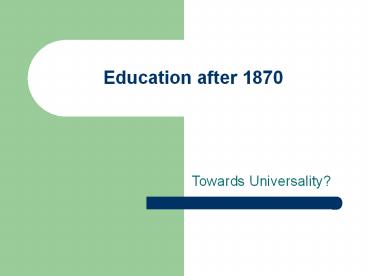Education after 1870 - PowerPoint PPT Presentation
Title:
Education after 1870
Description:
Education after 1870 Towards Universality? The Forster Education Act School Boards set up Board members elected Money used to fund existing and new schools Places ... – PowerPoint PPT presentation
Number of Views:308
Avg rating:3.0/5.0
Title: Education after 1870
1
Education after 1870
- Towards Universality?
2
The Forster Education Act
- School Boards set up
- Board members elected
- Money used to fund existing and new schools
- Places could be free for needy children
- Only Bible teaching allowed in Board schools
- Cowper-Temple clause gave parents the right to
remove children
3
How effective was the Act?
- Maintained and improved the existing system
- Religious division continued (re elections,
teaching, funding) - Payment by results and attendance continued
- By 1900, 54 pupils in Board schools. London
School Board built 400 schools - Three times as many children educated by 1900,
though many children still at work instead - Increasing cost unpopular with working class
4
How was the Act supported?
- 1873 outdoor relief made dependent on school
attendance - 1876 attendance made the responsibility of
parents - 1880 attendance compulsory for children aged
5-10 (fees waived for the poor). Leaving age 11
1893 and 12 - 1899 - 1890 payment by results in three Rs abolished
- 1891 Fee Grant Act virtually establishes free
elementary education
5
The Balfour Education Act - causes
- Some Boards had been spending on Secondary
education. Successful case brought against London
Board in 1901 - Some inefficient Boards (especially rural areas)
- Board of Education established in 1899
- Robert Morant at Board of Education
- Booth (London, pub. 1903), Rowntree (York, pub.
1899) - Desire for national efficiency
- Continued relative decline, Boer War
- Reactionary government? Remove power of elected
School Boards and increase CofE and grammar
influence
6
The Balfour Education Act, 1902
- Abolished School Boards
- Established LEAs (local Education Authorities)
- Money from rates could be spent on secondary
education - Fees required but scholarships also provided
- Money from rates could be spent on Voluntary
(Church) schools
7
How effective was Balfours Act?
- Numbers in secondary schools doubled from 94,000
in 1905 to 200,000 in 1914 - Many LEAs set up grammar schools for able pupils
- Provision for technical schools also available
- Criticism for expense and as a dangerous act of
State socialism - Middle classes benefited most
8
Balfours Act the religious issue
- Huge revolt of Non-conformists 7000
prosecutions for refusal to pay rates and 170 in
prison - Massive unrest in South Wales
- Rome on the Rates
- Based on view that funds from rates used for
Church schools. (Taxation had always done this to
some extent) - Contributes to election defeat in 1906?
9
Fisher Education Act - causes
- Collectivist/interventionist attitude
- Fisher at the Ministry of Education
- Working class vote
- Economic changes decline of traditional
industries beginning - Failure of Balfour Act to increase Sec Ed
significantly
10
Fishers Education Act, 1918
- Compulsory education until 14
- Elementary school fees abolished
- No children should be debarred through the
inability to pay fees - Encouragement for continuation classes past
school leaving age. Part time schooling ended - Proposals required from LEAs for all aspects of
education (nursery adult education)
11
How effective was Fishers Act?
- 1923 75 of all children in elementary
education - Only 7.5 receiving advanced instruction at
secondary/technical schools - Geddes Axe curtailed spending (51m in 1921 -
41m in 1924) - Massive extension of the scope of education
government grants to LEAs and teachers salaries
increased
12
Hadow Report, 1926
- Abolish elementary and replace with primary to
age 11 and secondary (grammar or modern) to age
15 - Secondary Education for Allirrespective of
income, class or occupation of their parents. - 2/3 of all children over 11 in modern schools
by 1938 (plus some in grammar) - School leaving age not raised in 1931 as planned
13
By 1939
- free places up from one third to ½.
- Total numbers up from 200,000 to nearly 1/2m.
- Total spending stayed about 6 of government
expenditure - Local authorities doubled expenditure and paid
for about 50 of education
14
Spens Report, 1938
- Accepted principle of free secondary education
and higher leaving age - Tripartite division modern, technical and
grammar - Encourage progressive methods curiosity, exam
focus - Widely applauded by teaching profession
- Conservative view of Board of Education and
threat and outbreak of war a brake on reform
15
Butler Education Act, 1944 Change?
- Schools monitored by LEAs and overseen by
Minister for Education. - All fees abolished
- Obligation to provide education sufficient in
number, character and equipment for all pupils - Primary and secondary introduced
- Leaving age set to rise to 16 in future
16
Butler Education Act - Causes
- R.A Butler as Minister for Education
- Spens, Hadow and Butler reports
- Britain questioning her place in the world
- WW2 increases intervention
- Previous experience/legislation
17
Butler Education Act Continuity?
- Interpreted so as to continue tripartite
division a small number of LEAs set up
comprehensive education - Private schools outside govt. control
- Built on previous practice and legislation
- Maintained hierarchic system
- RE and worship required in every state school
18
Education Reforms
- 1833 first government grant to education
- 1856 teacher training colleges set up
- 1861 payment by results
- 1870 Forster Act free elementary education
- 1902 Balfour Act establishes LEAs
- 1918 Fisher Act free and compulsory to 14
- 1944 Balfour Act primary/secondary
- - free and compulsory to 15































